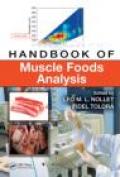
This book presents globally pertinent sensory, nutritional, and technological applications for muscle foods. In today's nutrition-conscious society, thereis a growing awareness among meat scientists and consumers about the importance of the essential amino acids, vitamins, and minerals found in muscle foods."Handbook of Muscle Foods Analysis" provides a comprehensive overview and description of the analytical techniques and application methodologies for this important food group that comprises much of the Western diet. With contributionsfrom more than 35 international experts, this authoritative volume focuses 16of its chapters on the analysis of main chemical and biochemical compounds, such as: Peptides; Lipases; Glucohydrolases; Phospholipids; Cholesterol products; and, Nucleotides.This book includes a section devoted to safety strategies,particularly the detection of environmental toxins. Under the editorial guidance of world-renowned food analysis expert, Leo M.L. Nollet with Fidel Toldra,this 43-chapter resource clearly stands apart from the competition. Divided into five detailed sections, it provides in-depth discussion of essential sensory tools to determine color, texture, and flavor. It also discusses key preparation, cleanup, and separation techniques. This indispensable guide brings available literature into a one-stop source making it an essential tool for researchers and academicians in the meat processing industry. INDICE: CHEMISTRY AND BIOCHEMISTRY. Importance of Analysis and Some Basic Concepts. Amino Acids. Peptides. Proteins. Proteomics. Muscle Enzymes: Proteinases. Muscle Enzymes: Exopeptidases and Lipases. Muscle Enzymes: Glycohydrolases. Fatty Acids. Triacylglycerols. Analysis of Phospholipids in Muscle Foods. Cholesterol and Cholesterol Oxides in Meat and Meat Products. Determination ofOxidation. Aroma. Carbohydrates. Nucleotides and Its Derived Compounds. PROCESSING CONTROL. Basic Composition: Rapid Methodologies. Moisture and Water-Holding Capacity. Microstructure of Muscle Foods. Physical Sensors and Techniques.NUTRITIONAL QUALITY. Composition and Calories. Essential Amino Acids. Trans and n-3 Fatty Acids. Vitamins. Minerals and Trace Elements. SENSORY QUALITY. Color Measurements on Muscle-Based Foods. Measuring Meat Texture. Techniques forSampling and Identification of Volatile Compounds Contributing to Sensory Perception. Sensory Descriptors. Sensory Perception. Sensory Aspects of Cooked Meats. SAFETY. Methods for Evaluating Microbial Flora in Muscle Foods. Methods to Predict Spoilage of Muscle Foods. Microbial Foodborne Pathogens. Parasites. Mycotoxin Analysis in Muscles. Detection of Genetically Modified Organisms. Detection of Adulterations: Addition of Foreign Proteins. Stable Isotope Analysis for Meat Authenticity and Origin Check. Determination of Persistent Organic Pollutants in Meat. Growth Promoters. Antibiotic Residues in Muscle Tissues ofEdible Animal Products. Index.
- ISBN: 978-1-4200-4529-1
- Editorial: CRC Press
- Encuadernacion: Rústica
- Páginas: 984
- Fecha Publicación: 17/11/2008
- Nº Volúmenes: 1
- Idioma: Inglés
